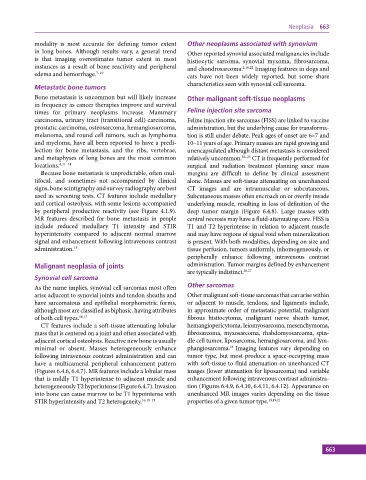Page 673 - Atlas of Small Animal CT and MRI
P. 673
Neoplasia 663
modality is most accurate for defining tumor extent Other neoplasms associated with synovium
in long bones. Although results vary, a general trend Other reported synovial associated malignancies include
is that imaging overestimates tumor extent in most histiocytic sarcoma, synovial myxoma, fibrosarcoma,
instances as a result of bone reactivity and peripheral and chondrosarcoma. 2,16,22 Imaging features in dogs and
edema and hemorrhage. 7–10 cats have not been widely reported, but some share
characteristics seen with synovial cell sarcoma.
Metastatic bone tumors
Bone metastasis is uncommon but will likely increase Other malignant soft‐tissue neoplasms
in frequency as cancer therapies improve and survival
times for primary neoplasms increase. Mammary Feline injection site sarcoma
carcinoma, urinary tract (transitional cell) carcinoma, Feline injection site sarcomas (FISS) are linked to vaccine
prostatic carcinoma, osteosarcoma, hemangiosarcoma, administration, but the underlying cause for transforma
melanoma, and round cell tumors, such as lymphoma tion is still under debate. Peak ages of onset are 6–7 and
and myeloma, have all been reported to have a predi 10–11 years of age. Primary masses are rapid growing and
lection for bone metastasis, and the ribs, vertebrae, unencapsulated although distant metastasis is considered
and metaphyses of long bones are the most common relatively uncommon. 23–25 CT is frequently performed for
locations. 4,11–14 surgical and radiation treatment planning since mass
Because bone metastasis is unpredictable, often mul margins are difficult to define by clinical assessment
tifocal, and sometimes not accompanied by clinical alone. Masses are soft‐tissue attenuating on unenhanced
signs, bone scintigraphy and survey radiography are best CT images and are intramuscular or subcutaneous.
used as screening tests. CT features include medullary Subcutaneous masses often encroach on or overtly invade
and cortical osteolysis, with some lesions accompanied underlying muscle, resulting in loss of definition of the
by peripheral productive reactivity (see Figure 4.1.9). deep tumor margin (Figure 6.4.8). Large masses with
MR features described for bone metastasis in people central necrosis may have a fluid‐attenuating core. FISS is
include reduced medullary T1 intensity and STIR T1 and T2 hyperintense in relation to adjacent muscle
hyperintensity compared to adjacent normal marrow and may have regions of signal void when mineralization
signal and enhancement following intravenous contrast is present. With both modalities, depending on size and
administration. 15 tissue perfusion, tumors uniformly, inhomogeneously, or
peripherally enhance following intravenous contrast
Malignant neoplasia of joints administration. Tumor margins defined by enhancement
are typically indistinct. 26,27
Synovial cell sarcoma
As the name implies, synovial cell sarcomas most often Other sarcomas
arise adjacent to synovial joints and tendon sheaths and Other malignant soft‐tissue sarcomas that can arise within
have sarcomatous and epithelial morphometric forms, or adjacent to muscle, tendons, and ligaments include,
although most are classified as biphasic, having attributes in approximate order of metastatic potential, malignant
of both cell types. 16,17 fibrous histiocytoma, malignant nerve sheath tumor,
CT features include a soft‐tissue attenuating lobular hemangiopericytoma, leiomyosarcoma, mesenchymoma,
mass that is centered on a joint and often associated with fibrosarcoma, myxosarcoma, rhabdomyosarcoma, spin
adjacent cortical osteolysis. Reactive new bone is usually dle cell tumor, liposarcoma, hemangiosarcoma, and lym
minimal or absent. Masses heterogeneously enhance phangiosarcoma. Imaging features vary depending on
18
following intravenous contrast administration and can tumor type, but most produce a space‐occupying mass
have a multicameral peripheral enhancement pattern with soft‐tissue to fluid attenuation on unenhanced CT
(Figures 6.4.6, 6.4.7). MR features include a lobular mass images (lower attenuation for liposarcoma) and variable
that is mildly T1 hyperintense to adjacent muscle and enhancement following intravenous contrast administra
heterogeneously T2 hyperintense (Figure 6.4.7). Invasion tion (Figures 6.4.9, 6.4.10, 6.4.11, 6.4.12). Appearance on
into bone can cause marrow to be T1 hypointense with unenhanced MR images varies depending on the tissue
STIR hyperintensity and T2 heterogeneity. 16,18–21 properties of a given tumor type. 18,19,21
663

